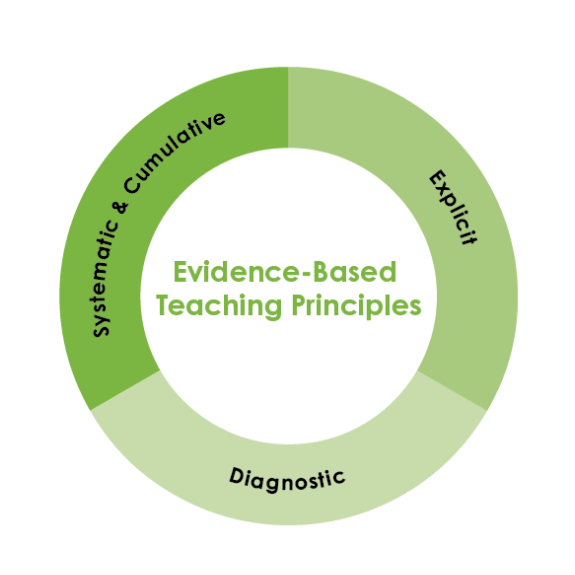What Is Structured Literacy?
The International Dyslexia Association originated the term structured literacy. It encompasses a science-based, structured approach to literacy instruction. It provides explicit, systematic, engaging, multisensory, and developmentally appropriate instruction. It teaches students the key skills they need to become efficient and accurate decoders. These skills lead not only to strong word identification but also to deeper text comprehension.

Structured literacy instruction uses evidence-based principles for instruction. These principles are:
- Systematic and Cumulative refers to the instructional order of concepts and the strategies for introducing those new concepts. In this approach, literacy instruction begins with the easiest concepts first and then moves on to more advanced concepts. Cumulative means that as each new concept is introduced, it is practiced in conjunction with the concepts that have been previously learned. Systematic and cumulative instruction logically builds on what students have already learned and focuses on the most useful concepts and skills first so that students can immediately put them to use reading real words.
- Explicit instruction means that there is direct student-teacher interaction in which the teacher clearly provides the needed information to the student in a palatable manner, not expecting the students to discover the information on their own. Explicit instruction levels the playing field because it does not assume prior knowledge. All students are given equal access to the concepts and skills needed to succeed.
- Diagnostic literacy instruction consists of ongoing assessment, formal and informal, of student needs and progress. The goal of instruction is student automaticity of key literacy concepts, enabling them to focus on meaning rather than the mechanics of decoding.
Successful literacy instruction and interventions provide highly explicit, systematic teaching of foundational decoding and spelling skills as well as explicit teaching of other important components of literacy, such as vocabulary, comprehension, and writing. (IDA 2021)
Phonemic Awareness and Phonological Awareness
- Phonemic awareness is what enables you to hear and manipulate the smallest units of speech sounds, phonemes. Your phonemic awareness gets the credit when you identify that the word map has three sounds, /m/ /ă/ /p/, while the word split has five, /s/ /p/ /l/ /ĭ/ /t/. Strong phonemic awareness skills lead to strong readers because phonemic awareness is the underlying framework for reading (decoding) and writing (encoding) (Trehearne, 2003).
- Phonological awareness, on the other hand, is what enables you to hear the sentence, “My dog ran away,” and immediately determine that it contains four spoken words. It allows you to quickly identify that bat and mat rhyme, while bat and boat do not. And it enables you to determine that the word loquacious has three syllables, lo-qua-cious.
Sound-Symbol Association and the Alphabetic Principle
Phonics instruction uses the alphabetic principle to teach sound-symbol association. The alphabetic principle, the idea that spoken words are made of individual sounds and that letters represent those sounds, is a key concept for developing reading skills. We believe in moving from speech to sound, from phonemes to graphemes. Grasping the alphabetic principle by moving from speech to print prevents errors, guessing, and other issues with decoding. Through explicit, structured activities, students develop the ability to use the alphabetic principle to match phonemes and graphemes.
Syllable Instruction
Syllable instruction is taught as part of phonics instruction. Phonics is the knowledge of the regular relationships between speech sounds and their spellings found in English. Phonics is the practical application of the alphabetic principle. This knowledge allows students to read words they have not encountered before. Phonics education should build automaticity in matching graphemes to phonemes through systematic, explicit instruction. When decoding (reading), knowledge of syllable types aids students in correctly identifying vowel phonemes; segmenting syllables; and, ultimately, blending the syllables together, leading to correct pronunciation. When encoding (spelling), the ability to segment syllables and identify their types helps students accurately match phonemes to graphemes.
Morphology
What is Morphology? It is the study of words and their parts. Morphemes are meaningful morphological units of a language that cannot be further divided. They are the smallest meaningful units of a language. Morphemes can be divided into prefixes, suffixes, and roots/bases. Morphemes are important for phonics in both reading and spelling, as well as in vocabulary and comprehension. By breaking words into six syllable types, we help students see patterns in decodable chunks. When this happens, morphemes naturally expose themselves.
Syntax
What is Syntax? It is defined as the arrangement of words and phrases to create well-formed sentences in a language. Syntax includes grammar and the structure, or rules, of written and spoken language. Good readers possess a variety of skills that, when combined, lead to text comprehension proficiency. These skills include decoding, fluency, a rich vocabulary, an understanding of various types of text, strong background knowledge, and an understanding of syntax.
Semantics
What is Semantics? It is defined as the meaning of a word, phrase, sentence, or text. When students can decode words accurately and automatically, they are better able to derive correct meaning when they read. Accurate and automatic reading can also lead to improvement in fluency because students will not stumble as frequently over unknown words, causing them to slow down and lose the meaning of the text. Improved accuracy, automaticity, and fluency lead to more confident readers.

